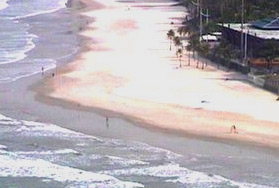
Praiamancy SP
(Webcam Beach Augury)
Will Pappenheimer and FRE
(The Florida Research Ensemble: Gregory L. Ulmer, Barbara Jo Revelle, John Craig
Freeman, Will Pappenheimer, and William Tilson)
Artwork and Technology Description:
The installation will consist of a configuration of one data entry computer
on a podium, a printer, and three contiguous RGB video projections on a nearby
wall. The right hand projection will display the continuous live monitoring
of a Sao Paolo beach webcam. The central projection will display a ghost
version of the webcam with bright image recognition points superimposed. The
third left-handed projection will display the results of textual searches when
the system is activated and a final diagrammatic sentence or series of words
that represents the users "reading."
The artwork functions as a sequence of automatic computational steps driven
by the input of a user collectively named PlayaSoft©. (1) At
the computer podium a visitor is asked for input on a simple series of questions
relating
to their memory and biography. When the information is entered, the user is
instructed to think of a question for consultation, to watch the progress of
the beach cam, and then to press the return or enter keys at the moment of
their choosing which initiates the automated process of the "reading." (2) The
return/enter key freezes the momentary image selection of the webcam. (3) This
still image is then subjected to the image recognition analysis and appears
in a dim version in the central projection with bright image recognition points
superimposed. (4) The entry/return action also initiates two
textual searches of the Internet. (5) Keywords, dates and
numbers from users question responses are filtered out and used as a keyword
searches for the WWW. (6) Local and
international news articles of the moment, are also retrieved in the search
stage of the software. (7) Sentences from information retrieved
from these searches are loaded into an unformatted text image defined as the
same size
as the Web cam image and displayed in the left-hand projection. (8) When
the text and imagery have completed their designated processes, the user is
prompted
to press return/entry again for the final processing step. (9) The
image recognition dots, forming the visual impression of a star configuration,
are super-imposed
on the text image in the far left projection. (10) Wherever
the dots are located in this super-imposition designates the words that become
the end product word
configuration or "reading." (11) This word configuration
or "reading" will
then be displayed as a moving and stretching lengthwise sentence or network
of words, It will be printed for the visitor as her/his particular consultation.
An Internet version of the artwork may also be possible.

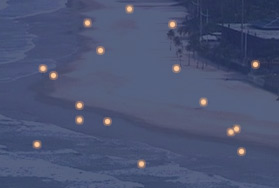
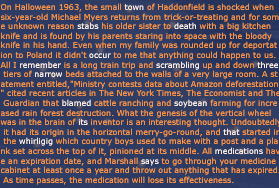
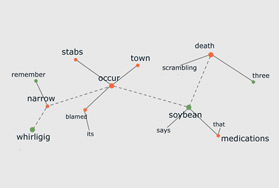
final text resullt screen and printout
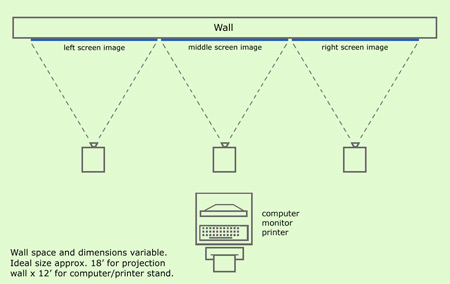
Background:
The proposed work represents a part of FRE's ongoing interest in exploring
electrate consultation systems which hybridize contemporary Western Arts
and Letters operations
with the wisdom epistemologies of Non-Western traditions. "Consulting" thus
refers not only to applied expert knowledge but also divination practices. Divination
offers a relay for composing cognitive maps connecting individual existential
problems with collective information resources. The switch or pivot between theory
and wisdom is the experience and notion of "situation." In Western
terms, circumstances transform into a situation through human intention, choice,
purpose. In divination, attunement between the individual and the collective
is achieved by a personal question to the oracle. In either case, the effect
of "situation" is the experience of responsibility.
Specifically, Praiamancy, (translated from a previous project: Playamancy)
is inspired by Roland Bathes' critical work, S/Z in which he
invokes augury in the exploration of writerly textuality. He proposes a "starred
text" in which each lexia or fragment is a "space in which we can observe
meanings." Playamancy pairs this hypertextual approach with the potential
of the image in Barthes' description of the "punctum" (Camera
Lucida) where photographs "...are in effect punctuated, sometimes
even speckled with these sensitive points...," a "...sting, speck,
cut, little hole- and also a cast of the dice." These sensitive points chart
an alternate potential of the image, one that is intimately tied to viewer memory
and profoundly tangential to normative pathways of signification. Similarly,
William Burroughs suggested, in his advocacy of a montage method of poesy, that
a cut up news article, particularly of a public issue, rearranged, can predict
the future of the problem.
Florida
Research Ensemble (FRE) is an interdisciplinary collaborative
group working collectively and individually on the invention of new digital
forms and the development of what Greg Ulmer, the group theorist, refers to
as electrate thinking in artistic production. Electracy is to information technology
what literacy is to alphabetic writing. Over the past eight years the FRE has
used Internet collaboration to produce numerous exhibitions, books, articles,
CD-ROMs, DVD-Data, videos, lectures, panel discussions and websites. The projects
and
CVs of its members can be accessed at www.floridaresearchensemble.net.
©Copyright images, text and ideas on this page